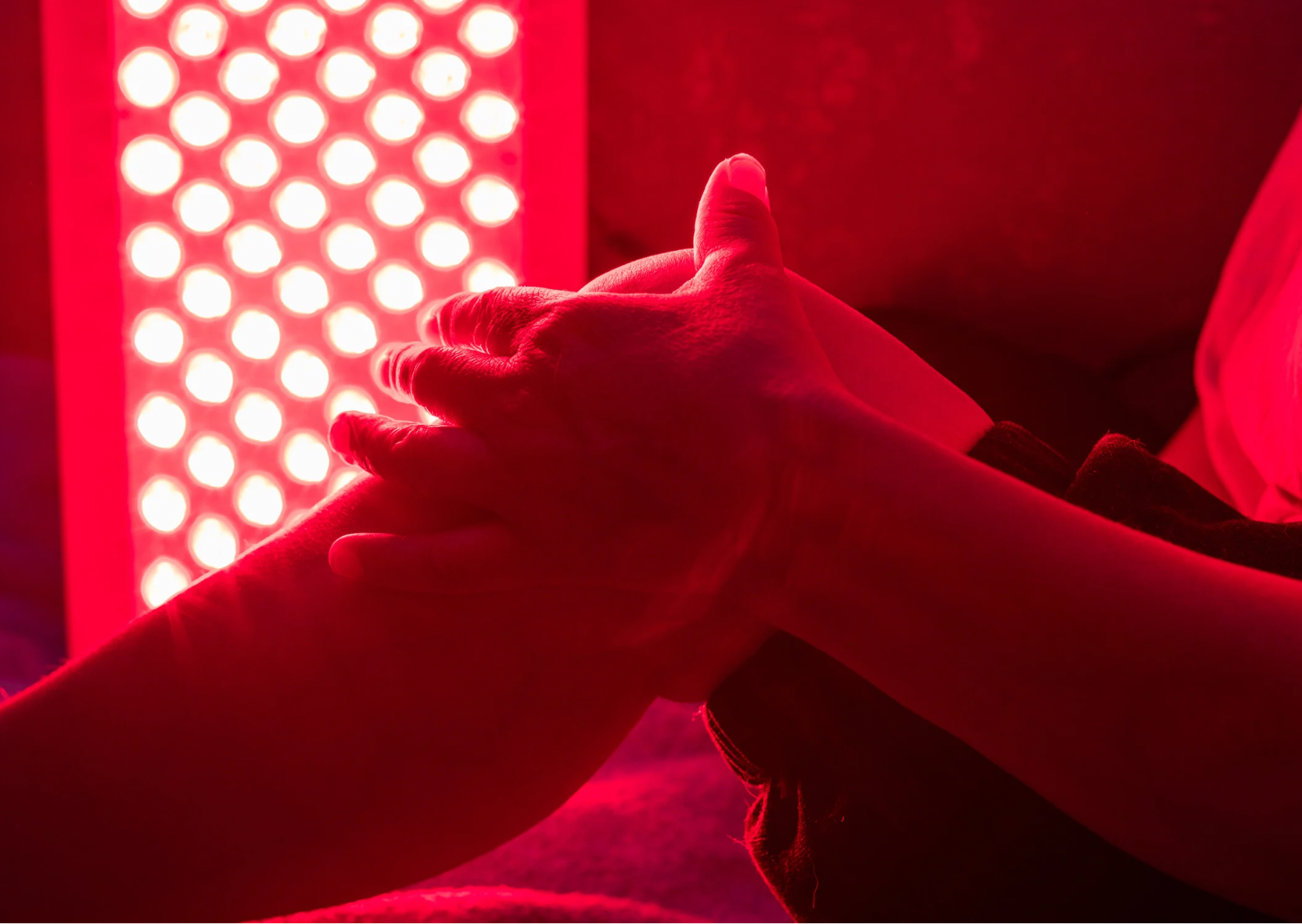Do you feel tired all the time? Get hangry easily (irritable or moody when hungry)? Do you struggle with healthy blood sugar, or get easily worn out while working out? Maybe you feel foggy, names or words escape you, or you hit a mid-afternoon energy slump?
These issues, among many others, may point to a common yet often overlooked problem: poor mitochondrial function.
The Powerhouses Within Our Cells
Think back to middle school biology class for a second. Remember the mitochondria being referred to as “the powerhouses of the cell”? This is because they’re vital for driving almost all of our body's metabolic processes.
Inside each cell, numerous mitochondria work tirelessly to convert the sugars and fats we consume into adenosine triphosphate (ATP), the currency of energy in our cells. This process is crucial for everything in our body to function, from burning fat and building muscle to digesting food, repairing tissues, and synthesizing hormones - name any process in the body; the mitochondria have your back.
How Modern Lifestyles Hinder Our Mitochondria
In the Western world, so many aspects of our lives are working against our mitochondria, compromising their efficiency. When your mitochondria are in top shape, you're more likely to feel great and stay healthy. But the mitochondria are sensitive and are easily harmed by things like imbalanced hormones or poor gut health, to name a few - all causing a plummet in energy production and overall health.
So what’s really damaging our mitochondria?
- Age. As we get older, the number and function of mitochondria naturally decrease by about 8% per decade. [1]
- Poor diet affects cellular metabolism (the body’s energy production process carried out by the mitochondria) e.g. overeating, consuming excessive sugar, ultra-processed low-nutrient foods, and poor gut health which leads to inflammation. Our mitochondria are negatively impacted by inflammation.
- Lifestyle choices reduce the stimuli to get the mitochondria working, disrupt recovery, and lead to prolonged inflammation e.g. smoking, stress, lack of sleep, sedentary lifestyle, poor light exposure.
- Temperature - the mitochondria are stimulated to produce heat when we’re cold and cool us down when we’re hot, but we’re never really cold anymore with our thermometers set within a comfortable range all day and night.
- Environmental toxins can cause inflammation and stress in the body, which messes with how your cells produce energy. More than 80,000 synthetic chemicals are found in our food, water, air, personal, and home cleaning products e.g. pesticides, herbicides, synthetic chemicals (like phthalates and BPA), and heavy metals.
The Domino Effect of Mitochondrial Dysfunction
The mitochondria are highly sensitive, and anything that causes inflammation in our body can impair their function. When damaging activities, like those listed above, negatively impact mitochondrial health, these "powerhouses of our cells" lose their efficiency.
Mitochondrial dysfunction can be one of the root causes underlying many diseases associated with metabolic syndrome, such as [2]:
- High blood sugar
- High triglycerides
- Low HDL cholesterol
- High waist circumference
- High blood pressure
It doesn’t stop there - Dr. Pizzorno suggests it could be under a number of other conditions too [3]:
The good thing is there’s been some ground-breaking science [4] pointing toward a new form of therapy that you can tap into to optimize your mitochondria from the comfort of your own home.
Of course, the information in the article below does not suggest that you disregard any other health-improving steps you've been taking. These steps remain beneficial, and if you're experiencing blood sugar issues, it's important to consult with your doctor too.
4 essential tips to optimize your mitochondrial performance…
Healthy mitochondria are KEY to health and energy - everyone is different so check with your doctor before starting any lifestyle or diet changes.
1. Diet
Out: Remove foods that create inflammation in our bodies. These are usually ultra-processed grains, sugars, and oils, like fried foods, cookies, sodas, etc. Processed foods are also good to avoid.

In: 5 essential vitamins, minerals, and amino acids for mitochondrial health are:
- B vitamins
- CoQ 10
- Carnitine
- Magnesium
- Alpha Lipoic Acid
Why are these important? Think of energy production in your body as a complex assembly line that relies on hundreds of compounds for each chemical reaction. Without an adequate supply of these compounds, the whole process is compromised.
If you don’t know where these essentials are, focus on getting these 5 things every meal:
- Fiber e.g. Oatmeal, Apples, Lentils
- Healthy Protein e.g. beans, fish, quinoa
- Omega-3 Fats e.g. Salmon, Chia seeds, Walnuts
- Antioxidants like polyphenols e.g. 1 tbsp of flaxseeds, a cup of Matcha or green tea, or a handful of blueberries
- Probiotic Sources e.g. Yogurt with live cultures, Sauerkraut, Kimchi
Fiber and high-quality protein are essential to stimulate the feeling of being “full” that processed foods can not do (in fact, the processed foods industry is designed to do the opposite to encourage you to keep consuming!). Eggs and avocados have also been shown to help with that feeling of satiety [5].
Opt for whole foods or minimally processed options whenever possible. Processing can strip foods of their beneficial nutrients. Additionally, the more flavorful your whole foods are, the more likely they are to contain phytochemicals, which are great for reducing inflammation. Plus, the flavor makes them more enjoyable to eat!
Bonus option: Time-restricted eating is gaining popularity and is well-researched for its ability to induce mild stress on the mitochondria. A common approach is an overnight fast of 12-16 hours. For women, it's important to consider your metabolic health since fasting may not always be the best option. A shorter 12-hour fast might be more effective for supporting hormone balance.
2. Movement & Exercise
Exercise increases the demand for energy in our body. This puts our body under mild stress, stimulating the body to make more energy. A little bit of stress is good for the mitochondria, helping them become more resilient and efficient.
How can we achieve this? Well, there’s 3 key types of exercise that serve different purposes when it comes to training, but they all put our body under necessary stress to stimulate the mitochondria.
Out: Sedentary behavior.
In: Zone 2 cardio training:
Comfortable effort exercise that you can hold for a long time without strain or heavy breathing. If you’re interested in heart rate monitoring too, it can be interesting to track this during your workout too, to stay within 60-70% of your maximum heart rate. A long slow run, a brisk walk, or a bike ride around a flat area are great examples to encourage your body to use both glucose and oxygen as fuel (aerobic exercise).
This type of low-load training can be a great option as it’s less physically demanding, making it a viable option for people who might not tolerate high stresses, such as older adults or those with certain health conditions [6].
Interval training:
This is a high-stress workout, so its important to keep intervals or sets short to prevent too much stress on the body. Each interval, like a 100m sprint, is a short severe exertion. In terms of reps, start small, then gradually increase so you can do 10-12 in a workout. Doing a workout 3x per week has huge benefits for our mitochondria.
Strength training:
Another good option to optimize mitochondrial performance. A high load and a low number of reps can improve mitochondrial respiration, hence increasing energy production [6].
3. Avoid environmental toxins and support detoxification pathways
Out: So many of the chemicals and heavy metals in our products today can either directly damage our mitochondria or disrupt their function; substances like BPA, phthalates, and pesticides. So reducing toxin exposure is a great way to support energy production to fuel all the processes in our body.
In: It is impossible to avoid all toxins, but these are a few good first steps:
- Get 7-9 hours of sleep at night to help the brain detoxify and remove metabolic waste from the day.
- Reduce consumption of toxic cleaning products or skincare, and consider investing in a good air purifier for your living space.
- Support liver and gut health to detoxify from the inside out - eating leafy greens, broccoli and broccoli sprouts, fatty fish, nuts, seeds, and olive oil are good options. Choose organic where possible, especially for the dirty dozen.
- Drink plenty of water
- Exercise, and sweat
Some people like to take supplements like CoQ10, L-carnitine, vitamin B complex, or Alpha-lipoic acid, which can be helpful, but we prefer to focus on something that can naturally support our mitochondrial health…
4. Get the right kind of light
Out: We are flooded by artificial lighting and blue light from our screens and devices. Too much of the wrong kind of light can be harmful, especially if we’re getting it at the wrong time of day. Avoid too much blue light at night, and make sure to dim overhead lighting to support your sleep hormones (and dial down the stress hormones for the day). When our circadian rhythms get thrown off, so do our mitochondria. Sleep is the optimal reset for mitochondrial function.
In: Start the day with 10-20 minutes of morning sunlight to energize your cells and support circadian rhythms. This is also great for vitamin D - an essential nutrient in that assembly line of reactions converting glucose to energy.
Maximize time outside during the day, as this may reduce the impact of blue light at night on our sleep hormones [7].
Use red light therapy:
- In the mornings, on the face and neck to energize the cells.
- Throughout the day on aches, pains, and sore muscles, to help reduce inflammation and support mitochondrial performance across the body.
- In the evening, as mood lighting to begin the wind-down process [8].
- A few hours before bed to calm stress hormones, balance sleepy hormones, and promote a restful night’s sleep.
What is Red Light Therapy?
Red Light therapy (RLT) is the safe application of red and near-infrared light waves to support cellular energy production. In other words, it helps our cells work better by providing more energy.
Since every cell in our body needs energy to work, this can aid in a variety of healthy functions:
- Healthy skin [9] (supporting the cells that make collagen, reducing the appearance of pimples and fine lines, reducing inflammation)
- Muscle gains and recovery [10, 11]
- Inflammation [12], pain [13], and joint health [14]
- Rest and relaxation [15, 16]
Red light therapy uses LED lights rather than laser (like those expensive treatment options in a salon) which makes them a safer yet effective approach to optimizing cellular performance across our entire body.

How Red Light Therapy supports cellular health
- ATP Production & Cellular Respiration:
Red and near-infrared wavelengths are able to penetrate the skin more effectively than other colors like blue and green. Our mitochondria have receptors for red and near-infrared light, and these wavelengths activate the cells to produce more ATP for energy. When our cells increase energy output, they can fuel all the processes that happen in our cells. This is why red light therapy is linked to skin health benefits, reducing inflammation, easing joint pain, healing wounds, relieving muscle soreness, improving rest, and more.
- Improving blood flow [17]
Nitric oxide (NO) acts as a barrier to ATP production by binding to a critical site in the energy production chain where oxygen normally would, making the process less efficient. Red and near-infrared light can help dislodge NO from this crucial spot, enhancing the efficiency of ATP production [18]. Once this NO is released, it can then diffuse into the bloodstream. NO is a vasodilator, meaning it relaxes the muscles of the blood vessels, allowing them to widen and increase circulation in areas exposed to red light.
- Reducing Oxidative Stress & Inflammation:
We spoke about the waste products of cellular respiration, one of which is ROS which generates a mild form of stress on our body. However, small amounts of ROS can be beneficial for our cells, nudging the mitochondria to make more energy.
Since red light therapy supports ATP production, it also activates the production of small amounts of ROS that help speed healing and anti-inflammatory processes in our bodies. [12]
- Mitochondrial Biogenesis:
Simply put, this is the creation of new mitochondria. Red light therapy may help increase the number of mitochondria in our cells [19]. Healthy mitochondria can make more healthy mitochondria, ensuring energy supply needs are met.
Here are a few ways to use LUMEBOX to support mitochondrial health:
- 5-6 minutes of red light during breathwork for healthy skin, and a mood and energy boost.
- Pre- and post-workout, in combined RED + NIR mode, over the muscle groups of focus for a 12-minute cycle. This may help decrease excess inflammation, reduce soreness, and improve recovery.
- 1-2 hours before bed, for 12 minutes on the back of the neck in NIR mode, to support better rest and re-energize the mitochondria.
New to red light therapy? Download our free eBook to help you choose the best device.
Already have a LUMEBOX? Download our 6 time-saving tricks guide!
Medical Disclaimer: The information contained in this blog post is intended for educational purposes only and should not be used as medical advice. Everyone responds to light differently. Testimonials are not a guarantee of the results you or anyone who uses LUMEBOX will get because your success depends entirely on your circumstances, and the studies on red light therapy shared were not specifically performed using LUMEBOX. Please check with your doctor before using red light therapy and do not change your medical treatments or lifestyle without consulting your physician first.
References:
[1] Short, K. R., Bigelow, M. L., Kahl, J., Singh, R., Coenen-Schimke, J., Raghavakaimal, S., & Nair, K. S. (2005). Decline in skeletal muscle mitochondrial function with aging in humans. Proceedings of the National Academy of Sciences of the United States of America, 102(15), 5618–5623. https://doi.org/10.1073/pnas.0501559102
[2] Prasun P. (2020). Mitochondrial dysfunction in metabolic syndrome. Biochimica et biophysica acta. Molecular basis of disease, 1866(10), 165838. https://doi.org/10.1016/j.bbadis.2020.165838
[3] Pizzorno J. (2014). Mitochondria-Fundamental to Life and Health. Integrative medicine (Encinitas, Calif.), 13(2), 8–15.
[4] Powner, M. B., & Jeffery, G. (2023). Optical stimulation of mitochondria reduces blood glucose levels. Preprint. https://doi.org/10.21203/rs.3.rs-3275287/v1
[5] Bodnaruc, A. M., Prud'homme, D., Blanchet, R., & Giroux, I. (2016). Nutritional modulation of endogenous glucagon-like peptide-1 secretion: a review. Nutrition & metabolism, 13, 92. https://doi.org/10.1186/s12986-016-0153-3
[6] Groennebaek, T., & Vissing, K. (2017). Impact of Resistance Training on Skeletal Muscle Mitochondrial Biogenesis, Content, and Function. Frontiers in physiology, 8, 713. https://doi.org/10.3389/fphys.2017.00713
[7] Blume, C., Garbazza, C., & Spitschan, M. (2019). Effects of light on human circadian rhythms, sleep and mood. Somnologie : Schlafforschung und Schlafmedizin = Somnology : sleep research and sleep medicine, 23(3), 147–156. https://doi.org/10.1007/s11818-019-00215-x
[8] Nagai, N., Ayaki, M., Yanagawa, T., Hattori, A., Negishi, K., Mori, T., Nakamura, T. J., & Tsubota, K. (2019). Suppression of Blue Light at Night Ameliorates Metabolic Abnormalities by Controlling Circadian Rhythms. Investigative ophthalmology & visual science, 60(12), 3786–3793. https://doi.org/10.1167/iovs.19-27195
[9] Lee SY, Park KH, Choi JW, Kwon JK, Lee DR, Shin MS, Lee JS, You CE, Park MY. A prospective, randomized, placebo-controlled, double-blinded, and split-face clinical study on LED phototherapy for skin rejuvenation: clinical, profilometric, histologic, ultrastructural, and biochemical evaluations and comparison of three different treatment settings. J Photochem Photobiol B. 2007 Jul 27;88(1):51-67. Epub 2007 May 1.
[10] Ferraresi, C., Huang, Y. Y., & Hamblin, M. R. (2016). Photobiomodulation in human muscle tissue: an advantage in sports performance?. Journal of biophotonics, 9(11-12), 1273–1299. https://doi.org/10.1002/jbio.201600176
[11] Hemmings, T. J., Kendall, K. L., & Dobson, J. L. (2017). Identifying Dosage Effect of Light-Emitting Diode Therapy on Muscular Fatigue in Quadriceps. Journal of strength and conditioning research, 31(2), 395–402. https://doi.org/10.1519/JSC.0000000000001523
[12] Hamblin M. R. (2017). Mechanisms and applications of the anti-inflammatory effects of photobiomodulation. AIMS biophysics, 4(3), 337–361. https://doi.org/10.3934/biophy.2017.3.337
[13] Yousefi-Nooraie, R., Schonstein, E., Heidari, K., Rashidian, A., Pennick, V., Akbari-Kamrani, M., ... Mortaz-Hedjri, S. (2008). Low level laser therapy for nonspecific low-back pain. Cochrane Database of Systematic Reviews, (2), Art. No.: CD005107. https://doi.org/10.1002/14651858.CD005107.pub4
[14] Stelian J, Gil I, Habot B, Rosenthal M, Abramovici I, Kutok N, Khahil A. Improvement of pain and disability in elderly patients with degenerative osteoarthritis of the knee treated with narrow-band light therapy. J Am Geriatr Soc. 1992 Jan;40(1):23-6. doi: 10.1111/j.1532-5415.1992.tb01824.x. PMID: 1727843.
[15] Zhao, J., Tian, Y., Nie, J., Xu, J., & Liu, D. (2012). Red light and the sleep quality and endurance performance of Chinese female basketball players. Journal of athletic training, 47(6), 673–678. https://doi.org/10.4085/1062-6050-47.6.08
[16] Yeager, R. L., Oleske, D. A., Sanders, R. A., Watkins, J. B., 3rd, Eells, J. T., & Henshel, D. S. (2007). Melatonin as a principal component of red light therapy. Medical hypotheses, 69(2), 372–376. https://doi.org/10.1016/j.mehy.2006.12.041
[17] Mak, M. C., & Cheing, G. L. (2012). Immediate effects of monochromatic infrared energy on microcirculation in healthy subjects. Photomedicine and laser surgery, 30(4), 193–199. https://doi.org/10.1089/pho.2011.3012
[18] Brown G. C. (2001). Regulation of mitochondrial respiration by nitric oxide inhibition of cytochrome c oxidase. Biochimica et biophysica acta, 1504(1), 46–57. https://doi.org/10.1016/s0005-2728(00)00238-3
[19] Karu T. Primary and Secondary Mechanisms of Action of Visible to Near-IR Radiation on Cells. Journal of Photochemistry Photobiology. 1999 Mar.






